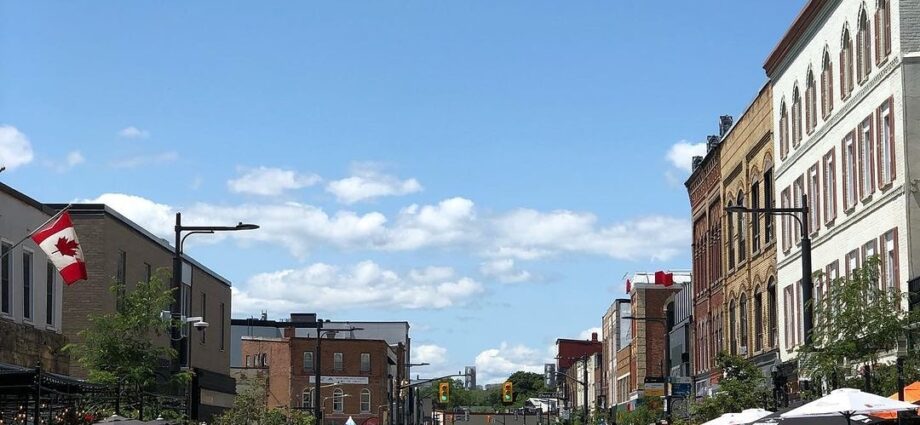Here at Pedestrian Space, we love to follow accounts that show great passion for place. @the.heartofbarrie is an incredibly engaging example of such an account. @the.heartofbarrie is run by Sarah Jensen, who grew up and lives in Barrie, a city of 150,000 people in Canada. By day she works as a barista in a little cafe called Bohemia and runs the cafe’s social media. This year she also joined the Downtown Barrie BIA (business improvement area) acting as their secretary-treasurer. The Downtown Barrie BIA organizes events and festivals, works to enliven the spaces between buildings, and strives to create a strong and vibrant community within the city’s downtown.
Interview with Sarah Jensen of @the.heartofbarrie
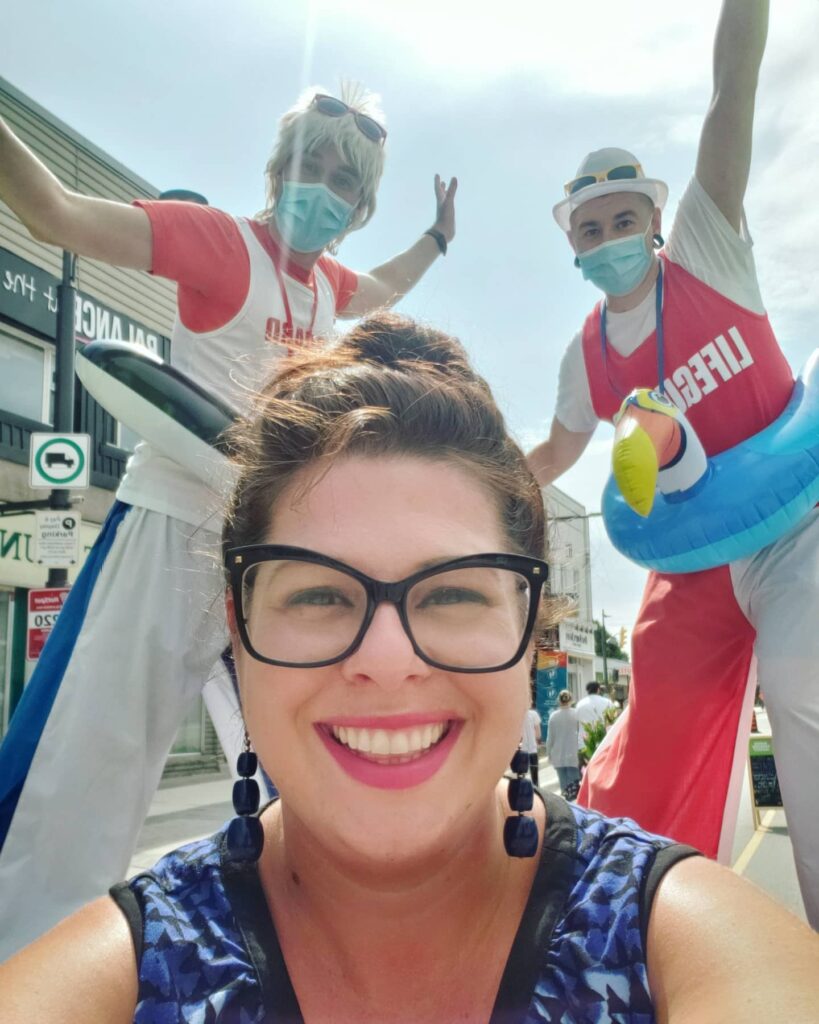
What is the background of The Heart of Barrie?
The Heart of Barrie actually started as a printed publication, telling the stories behind the businesses in our downtown, encouraging people to support local, and promoting community. It was founded by acquaintances I knew from working in the area, Carly Gouweloos and Jacqui Derbecker.
I really loved the idea and joined as a writer, later taking over as editor about 6 years ago when Carly moved away for school. When the pandemic began, we decided to fold the print edition. We had a Facebook page, which I kept active and I decided to start an Instagram account as well.
The change in formats was freeing. I’m not great with deadlines! By running it as a social media account I’m able to get information out faster, more frequently, and have a much larger reach. The print edition was funded by sponsors, and now I’m beholden to no one and am able to explore other topics, such as looking at what other cities around the world are doing, and share ideas about urbanism, walkability, placemaking, public art and such.
I aim to celebrate what makes my city unique and explore ways of making it better. The Heart of Barrie is a location, in the centre of the city, but more so it’s the community. As Shakespeare wrote, “What is the city, but the people?
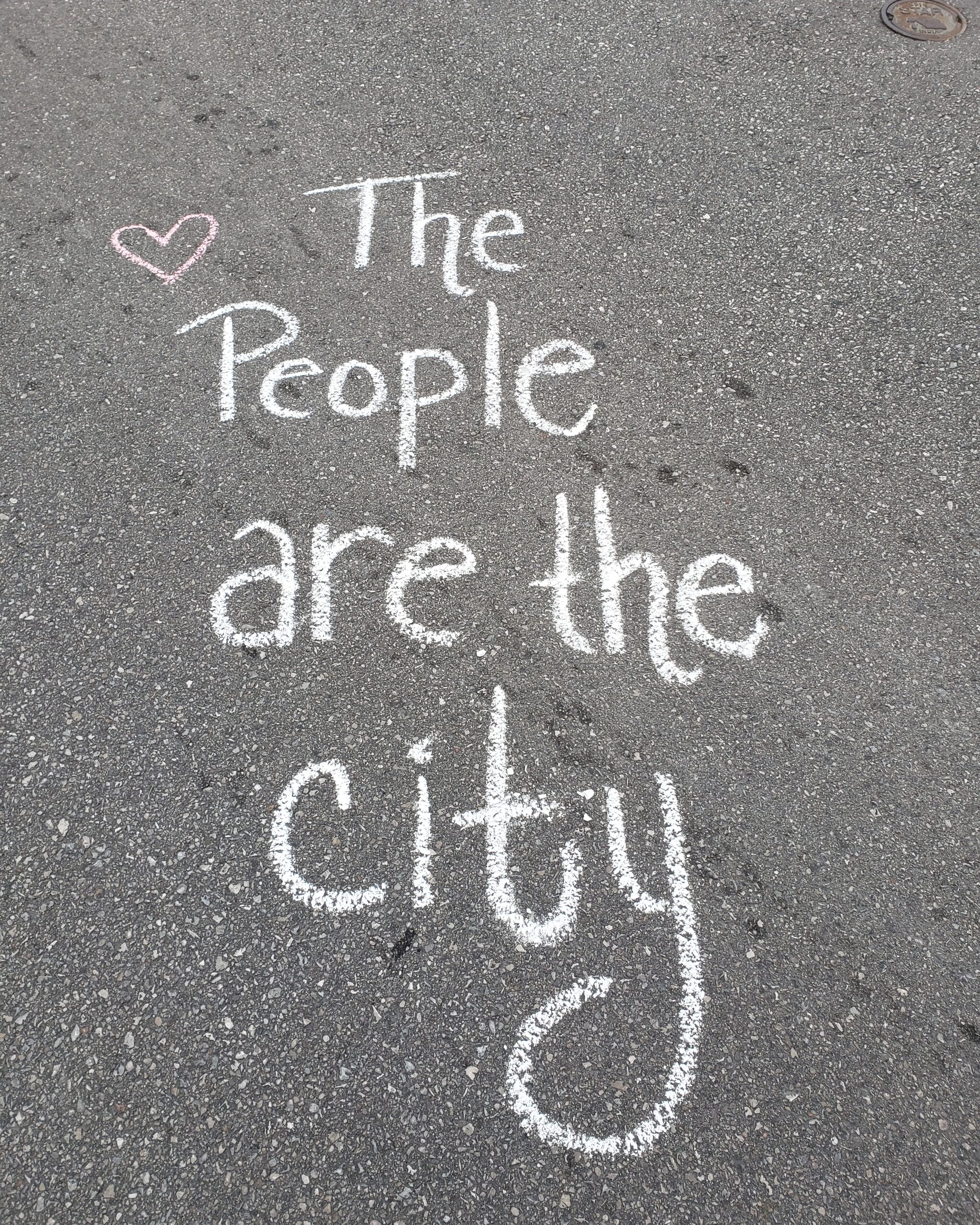
“We recently launched walkablebarrie.ca, a site where citizens can sign up to be notified of opportunities to provide feedback to the city about making our streets safer and more walkable.”
What is the geography of Barrie?
Barrie’s is located on Kempenfelt Bay, on the shores of Lake Simcoe, about 90 km north of Toronto in Canada. We’re the 9th biggest city in the province of Ontario and 21st in Canada. While we’re not a huge city, for all my life it’s been a fast-growing, sprawling one. When my family moved here in 1984 the population was around 45,000, it’s now 153,000 and projected to double by 2051.
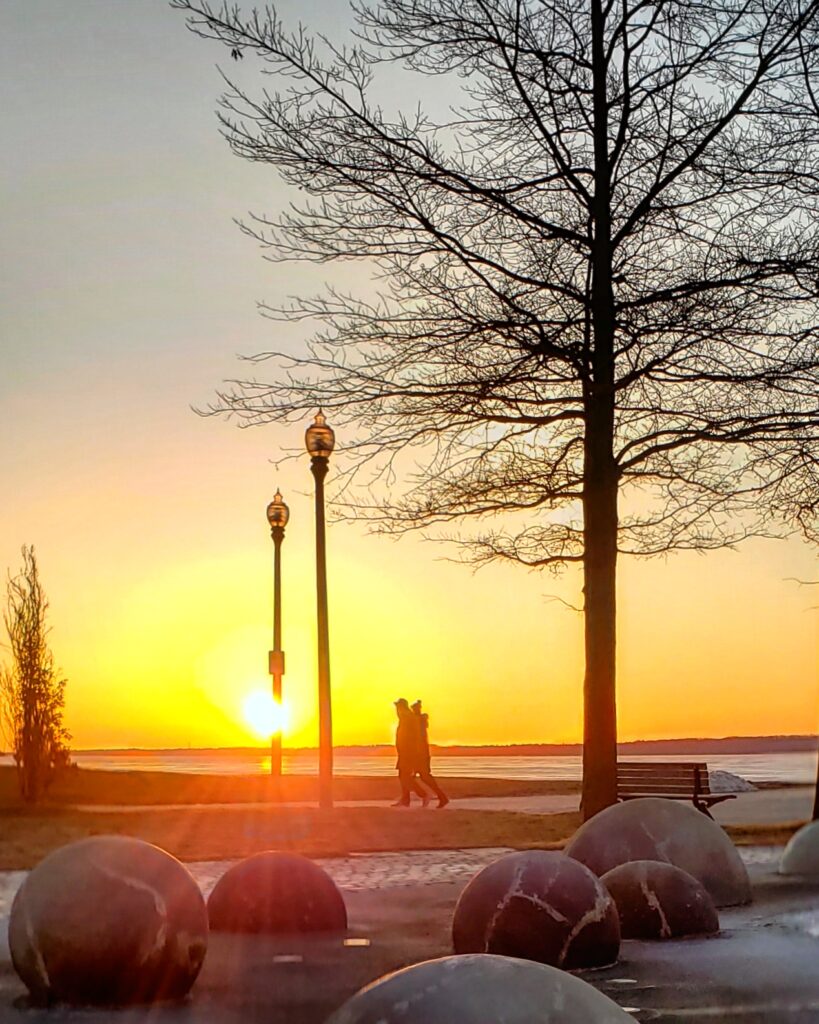
“I’ve fallen in love with my city twice.”
Why are you passionate about Barrie?
Like a lot of people, at times I have a love/hate relationship with my hometown. Growing up near Toronto, I’ve always been drawn to the bright lights of the more exciting big city. Being close to family and the lower cost of living kept me here though. Luckily my childhood best friend made the leap to city life and has always offered me a couch to crash on, so I’m able to experience a bit of the best of both worlds.
One of my favourite ways to spend a day is just walking around Toronto until my legs are ready to give out, pausing to take pictures, rest in parks, grab a bite to eat, consult Google Maps, smoke a joint and carry on. It’s the most multicultural city in the world, so there’s always something new to see and always something happening.
But getting back to Barrie, I’ve fallen in love with my city twice. The first time was when I started working downtown about eight years ago. I’d previously worked for large telecommunications and banking companies and found myself feeling burnt out from corporate life. I took a cut in pay and began working at a small shop on the main street that sold food grown and produced mostly within 100 miles. And I began walking the half-hour to work each day (home is entirely uphill, so I often catch a ride with a co-worker or hop the bus). Those two changes helped me feel so much more connected to my community and helped me find myself at the same time.
Around that time, I picked up my first book on urbanism, Suburban Nation: The Rise of Sprawl and the Decline of the American Dream. My mind was blown. It was followed by Happy City, and between the two books I began to realize just how much our surroundings and how we build our cities affect our health and happiness.
The troubles of the world often keep me awake at night; figuring out a way to make an impact is daunting. But cities have the potential to make a tremendous change. And if enough people in enough cities push for change, it can have a worldwide impact.
The second time I fell in love with my city was during the pandemic. Though there are times I wanted nothing more than to escape the confines of Barrie, being trapped within the boundaries of my city made me appreciate it more. At times we were locked down to everything but pharmacies, food stores and restaurant takeout (and curbside pickup for anything else considered essential). I was pretty much confined to my neighbourhood. But I’m very fortunate to live near a former golf course that was turned into the largest park in town; we were still allowed outside for fresh air and exercise so I escaped there often. And I live within walking distance of a large Asian grocery store, a Polish deli and grocer, and an Indian food shop. So though I was trapped in Barrie and my world suddenly became very small, I could still explore new sights and tastes and travel in my mind.
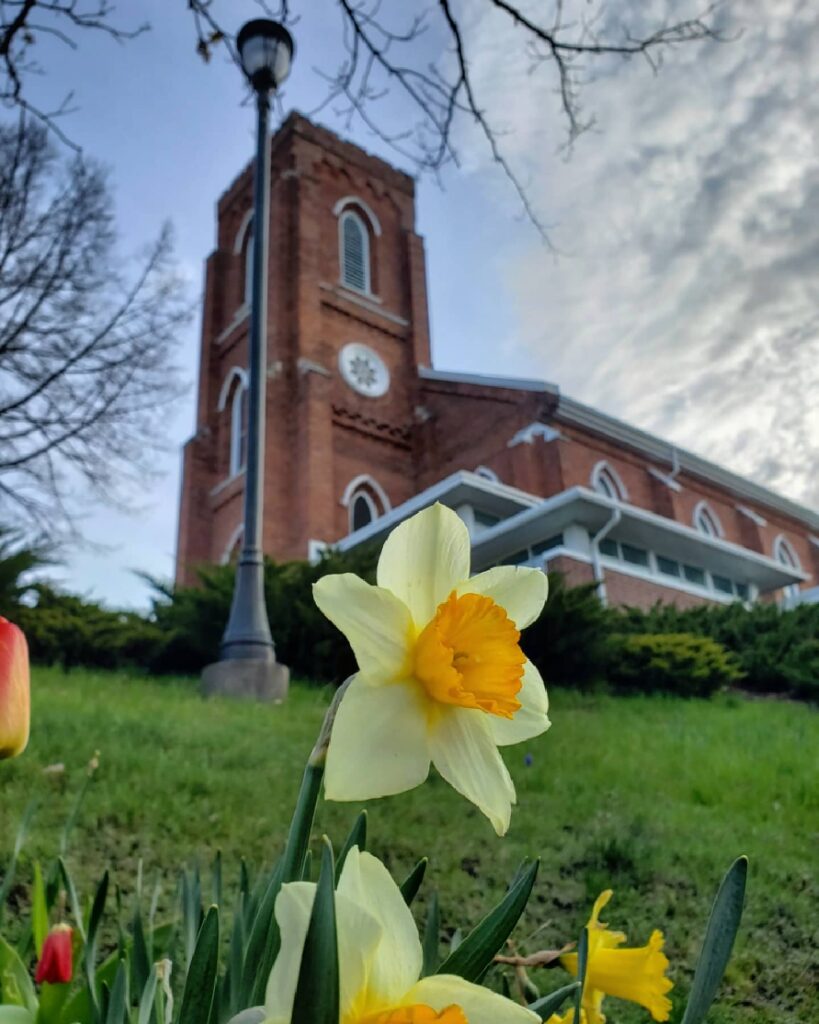
There’s a lot I love about my city, but there’s much in Barrie that needs fixing. We recently pulled ahead of Toronto to become the most expensive city to rent in our province, and we’re now the third highest in Canada. We don’t have a university, so we lose many of our best and brightest minds when they move away for post-secondary school. In a 2019 study, Barrie was found to be the worst large city in Canada to be a woman, factoring in safety, income, education and leadership. And we’ve been hit especially hard by the opioid crisis.
“An often overlooked aspect of walkability is not just “can I walk” but “do I want to walk?” And the big box stores with vast parking lots and winding cookie-cutter suburban roads that dot much of the city discourage walking, as does the lack of public washrooms and spots to rest and take shade from the sun.”
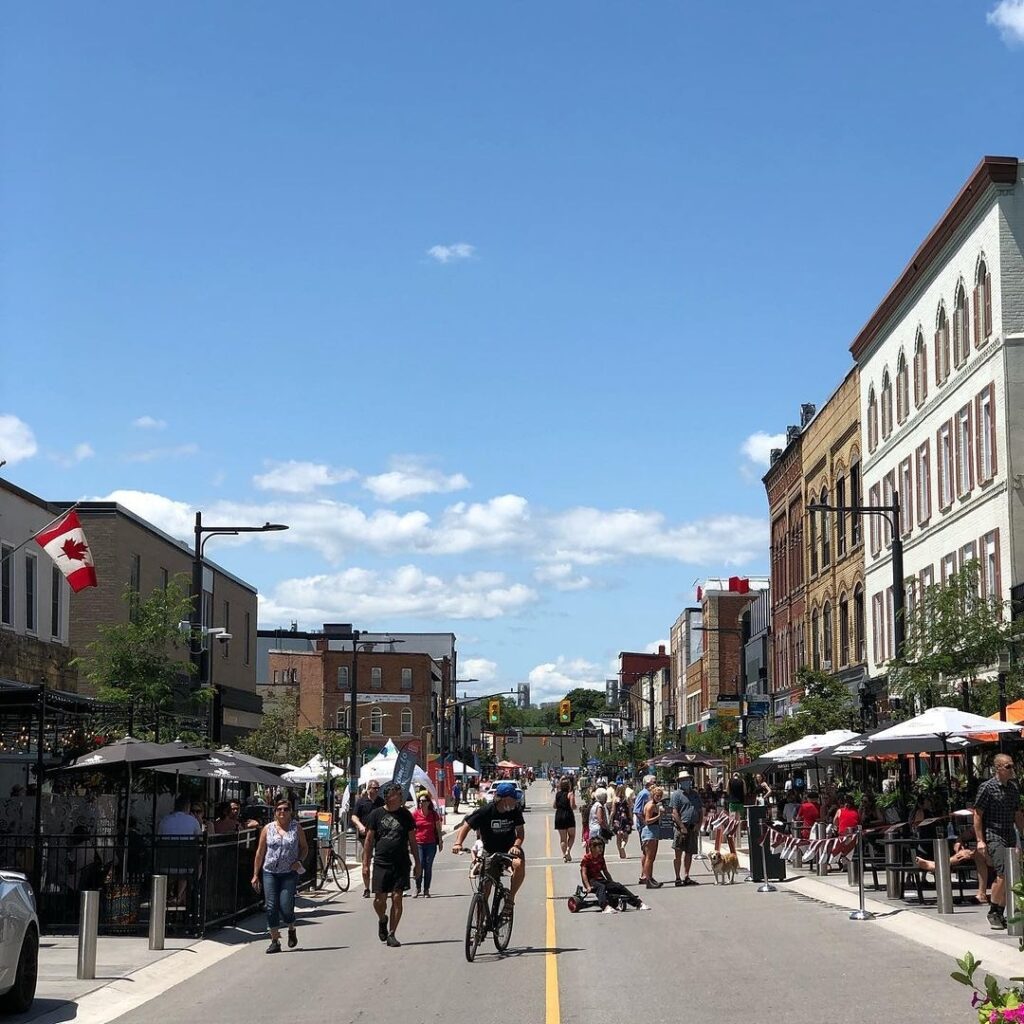
What would your ideal day around Barrie be like?
My ideal day would be heading downtown on a Saturday morning, stopping at a cafe for coffee, and then wandering around the Barrie Farmers Market. I work most Saturdays, so don’t get to visit very often. I’d pick up fresh bread, honeycomb, strawberries, Syrian cheese pies and whatever else caught my eye. Most times at the market I run into people I know; smiles and waves are exchanged and sometimes conversations.
Then I’d walk by the waterfront and find a grassy spot to picnic, lounge and read. Afterward, I’d head to our main street for Open Air Dunlop, our pedestrian days. They were started as a pilot project last year, closing down the road to vehicles to make room to stroll, roll, shop and patio hop. The idea was considered risky by many, it’s still a fairly novel idea in North America, but the pandemic has allowed and even forced cities to think outside the box and try new ideas. It’s been a great success and there’s such a fantastic vibrant community feel on Saturdays now.
From there I’d walk over to Centennial Beach for a swim and an ice cream from the concession stand. And later I’d meet friends at a patio for drinks and snacks while the sun goes down.
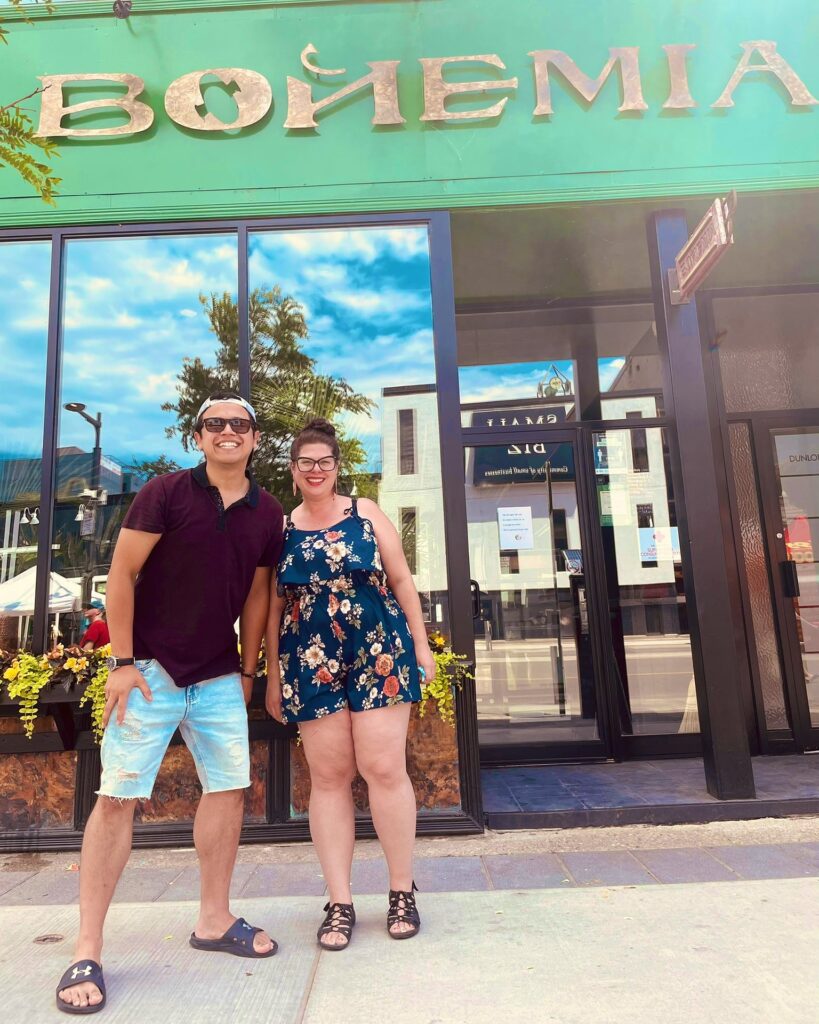
You weave together so much fantastic Barrie-related content on your platforms. Can you share more about the “behind the scenes” of this content creation? It of course involves being plugged into many different accounts and local media streams and you also produce a lot of content yourself. Can you share more about your content creation and media and how it all weaves into your daily life?
A large part of my content creation is just spending far too much time on social media! I like to seek out and share the good. The page also works as an idea board of sorts for myself, a place to collect information that I can come back to. There are a lot of local individuals and community groups doing amazing things that I follow, so I try to amplify their messages.
I also follow all the local businesses downtown and try to stay in the loop on what’s happening in the neighbourhood. Working in a coffee shop gives me a great advantage. It’s such a community hub; I get the chance to connect with a lot of people there. And I follow pretty much any Instagram account I run across that has to do with urbanism. I blend reposting from those accounts with original content.
I get around mostly on foot and often stop to snap pictures. There’s a series I do called “Walk With Me” that features things around town that catch my eye. Walking allows for free-flowing thought, so it’s often when I have my best ideas. Sometimes I’ll share the history of an old building or talk about a public art project. And other times it’s ranting about poor pedestrian infrastructure.
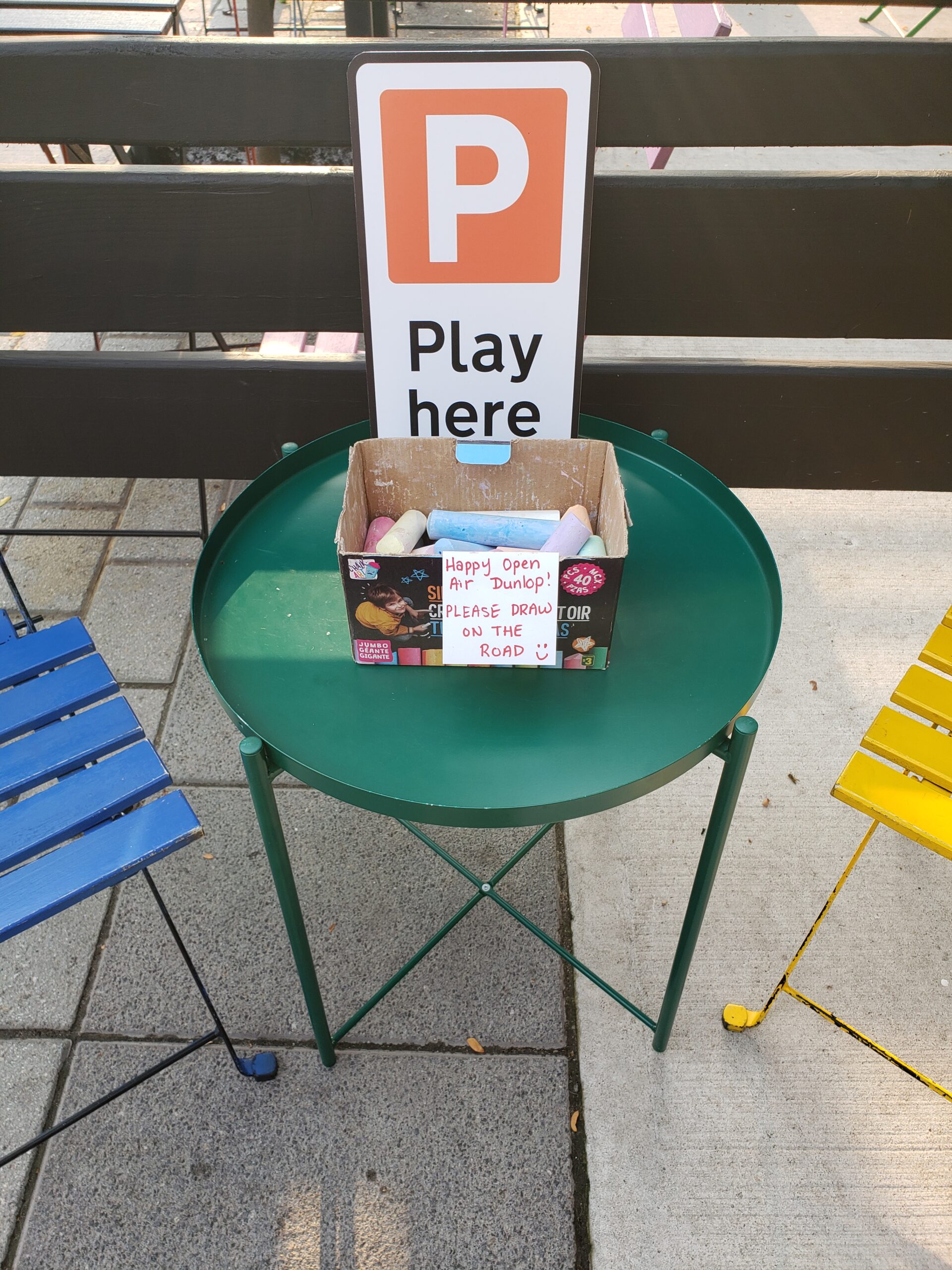
What are some of your favorite reads on Urbanism? What are you reading now and have coming up on your book stack for later this year?
I previously mentioned Happy City by Charles Montgomery and Suburban Nation by Andres Duany, Elizabeth Plater-Zyberk and Jeff Speck. I’m also a big fan of Walkable City by Jeff Speck and I’m re-reading it now. Of course, I adore The Life and Death of Great American Cities by Jane Jacobs; I hope to make a pilgrimage to her Toronto home. And Jane’s Walks, inspired by the author, are one of my favourite things ever; they’re citizen-led walking conversations, taking place in hundreds of cities all over the world in the first weekend of May.
Cities for People by Jan Gehl is another one I’m reading off and on—it’s so full of information that it’s good to pause sometimes and let the ideas sink in. I also just ordered Curbing Traffic: The Human Case for Fewer Cars in our Lives by Melissa and Chris Bruntlett.
In other media, I’m a fan of the show the Life-Sized City, hosted by Mikael Colville-Anderson. And the podcasts the War or Cars, 360 Degree City, Monocle 24: The Urbanist, and Streets Ahead.
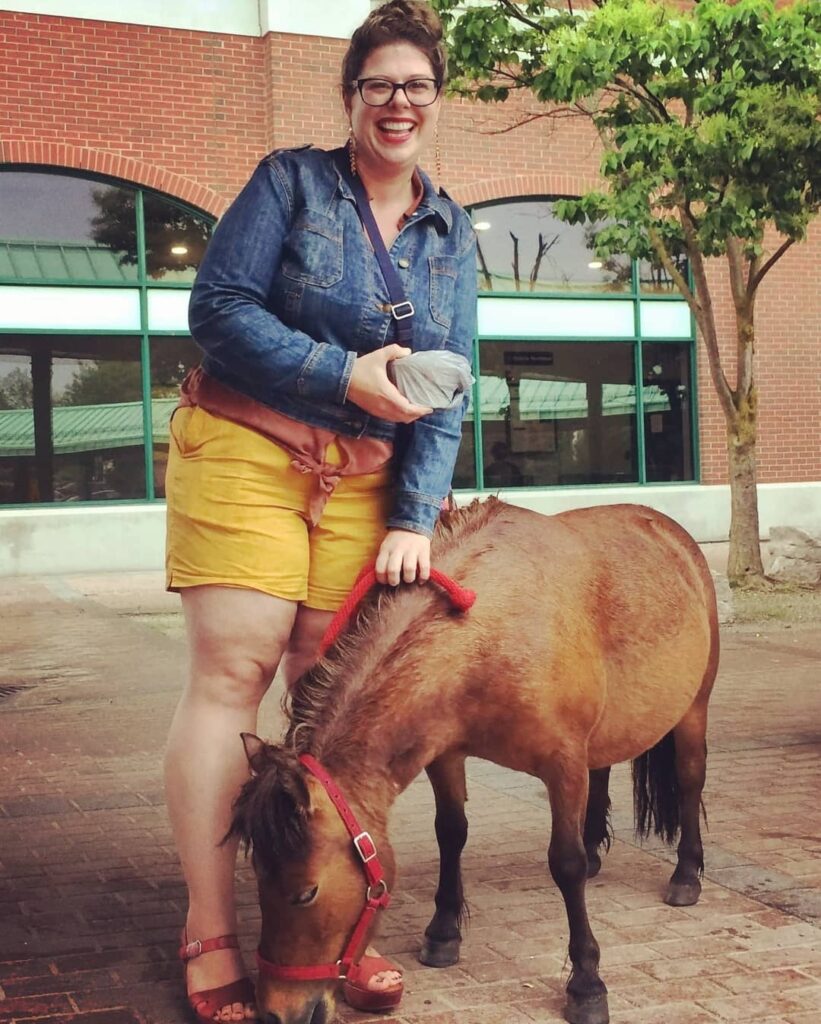
“There’s a series I do called “Walk With Me” that features things around town that catch my eye. Walking allows for free-flowing thought, so it’s often when I have my best ideas. Sometimes I’ll share the history of an old building or talk about a public art project. And other times it’s ranting about poor pedestrian infrastructure.”
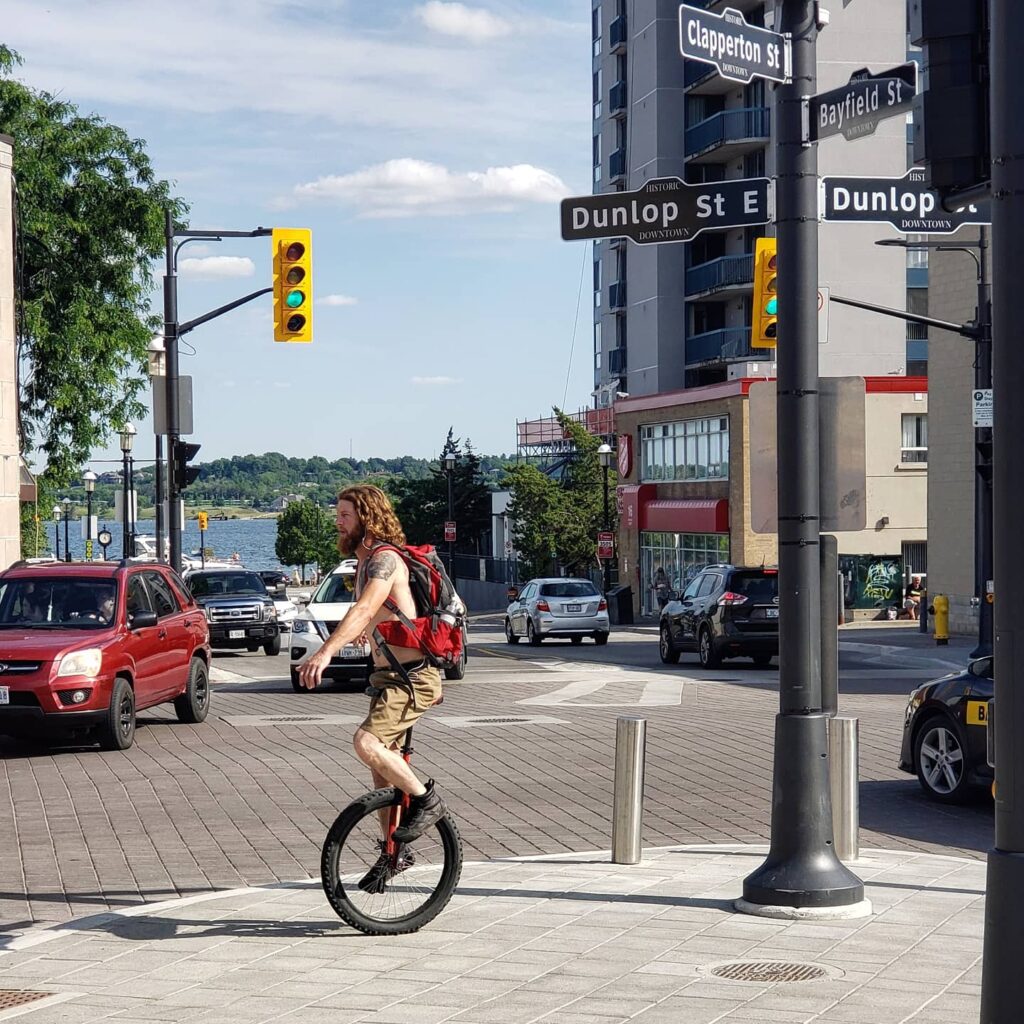
Can you share about the walkability of Barrie and any changes you see occurring or advocated for?
Barrie has a long way to go when it comes to walkability. Our downtown was built in the age before automobiles, so it’s quite compact and walkable, but the rest of the city is very auto-centric. I live just off of one of the busiest roads in town. It’s quite handy to a lot of things, but very unpleasant to walk along, and I was hit by a car while walking to work one morning a couple years ago while crossing the street. A friend of mine was struck and killed by a vehicle one night while he was walking home from work.
As many cities in Europe and even some in North America are restricting cars in their city centres and making room for people on foot and bike, Barrie is widening its busiest roads, making room for more traffic. Many streets only have sidewalks on one side, sidewalks that end abruptly, or no sidewalks at all.
An often overlooked aspect of walkability is not just “can I walk” but “do I want to walk?” And the big box stores with vast parking lots and winding cookie-cutter suburban roads that dot much of the city discourage walking, as does the lack of public washrooms and spots to rest and take shade from the sun.
There are some people pushing for change, though. I ran across an article in the local paper written by a citizen named Hannah Bergman, who advocated against plans to widen Bradford Street and instead make the area more walkable. I connected with her on Instagram and we became friends, forming what we jokingly refer to as an “urban planning nerd club.” We both joined a task force that’s looking at the streetscape and public spaces in the west end of our downtown, an area the city hopes to revitalize when they move the Barrie Farmer’s Market. We hope to make it as easy and appealing as possible to arrive on foot, bike or bus. We also recently launched walkablebarrie.ca, a site where citizens can sign up to be notified of opportunities to provide feedback to the city about making our streets safer and more walkable.
Another local environmental group, the Simcoe County Greenbelt Coalition, recently did a great series on social media about the benefits of low-car cities. And Barrie has an Active Transportation and Sustainability Committee, whose meetings I try and tune into as often as I can.
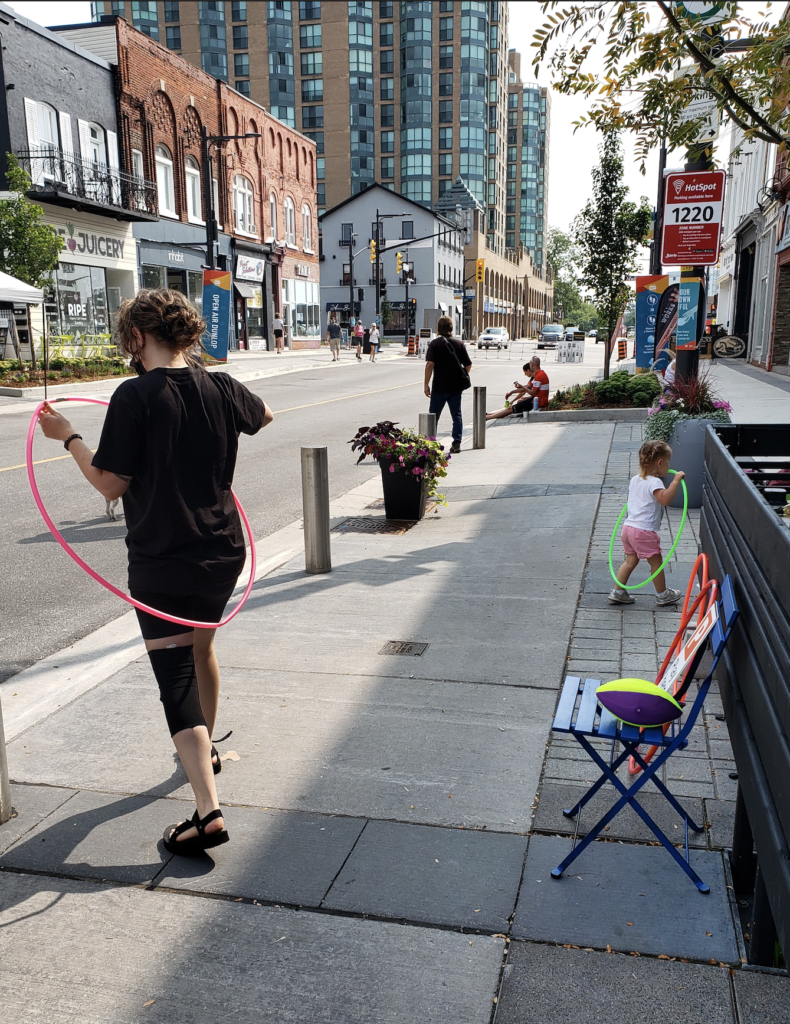
Can you share about any other aspects of urban mobility currently underway there?
Barrie is serviced by 10 two-directional bus routes in town. Transit had been slowly improving, but it took quite a hard hit with covid. Ridership is down, the most recent stat I could find has us at 40% of what it once was and not expected to return to pre-pandemic levels until 2022 or 2023. Along with ridership, of course revenues are down, which has resulted in reduced service levels. Oftentimes these days it’s faster for me to walk than wait for a bus, but not everyone has that option.
There’s a definite class divide as far as who takes transit in Barrie. In June our city council adopted a motion that endorses the conversion of our bus fleet to electric vehicles. It looks like it’ll take some time to be implemented, but it’ll be a positive change. Our plans to increase ridership aren’t nearly ambitious enough though. In our transportation master plan, we’re aiming to increase our transit mode share from 2% (2016) to 7% by 2041.
In 2007 we were reconnected to Toronto by train, giving an alternative option for commuters and day-trippers to the city. Taking the train is quite nice, especially if you’re able to snag a spot with an electrical outlet. On weekday mornings the top floor of the train cars is a quiet zone and there’s a church-like hush observed by sleepy travellers; I’ve enjoyed many a train nap on the hour and a half long journey. The schedules are fairly limited for the time being, tailored to commuters; the last morning train leaves Barrie at 8am. If you want to sleep in, your option later in the day is a 2.5-hour bus ride with a transfer halfway. Reading about sustainable and vibrant cities, I know that bikes are an important part of the equation. After not riding in about 20 years, I invested in an e-bike earlier this spring. Riding in Barrie still makes me nervous, though, and I haven’t used it as much as I’d hoped I would. Bike lanes are rare and often enforced with only paint. There’s a gorgeous waterfront trail winding around the bay downtown, but it’s a matter of getting there to enjoy it. Our downtown also displays outdated and incorrect bylaw signs that prohibit bicycles. I was able to get one set of signs fixed to specify it’s no bikes allowed on sidewalks (they’re permitted on sidewalks in the rest of town). But the no bikes proclamation remains on the unfriendly bylaw list that also includes no loitering. It’s my personal mission to get those signs removed.
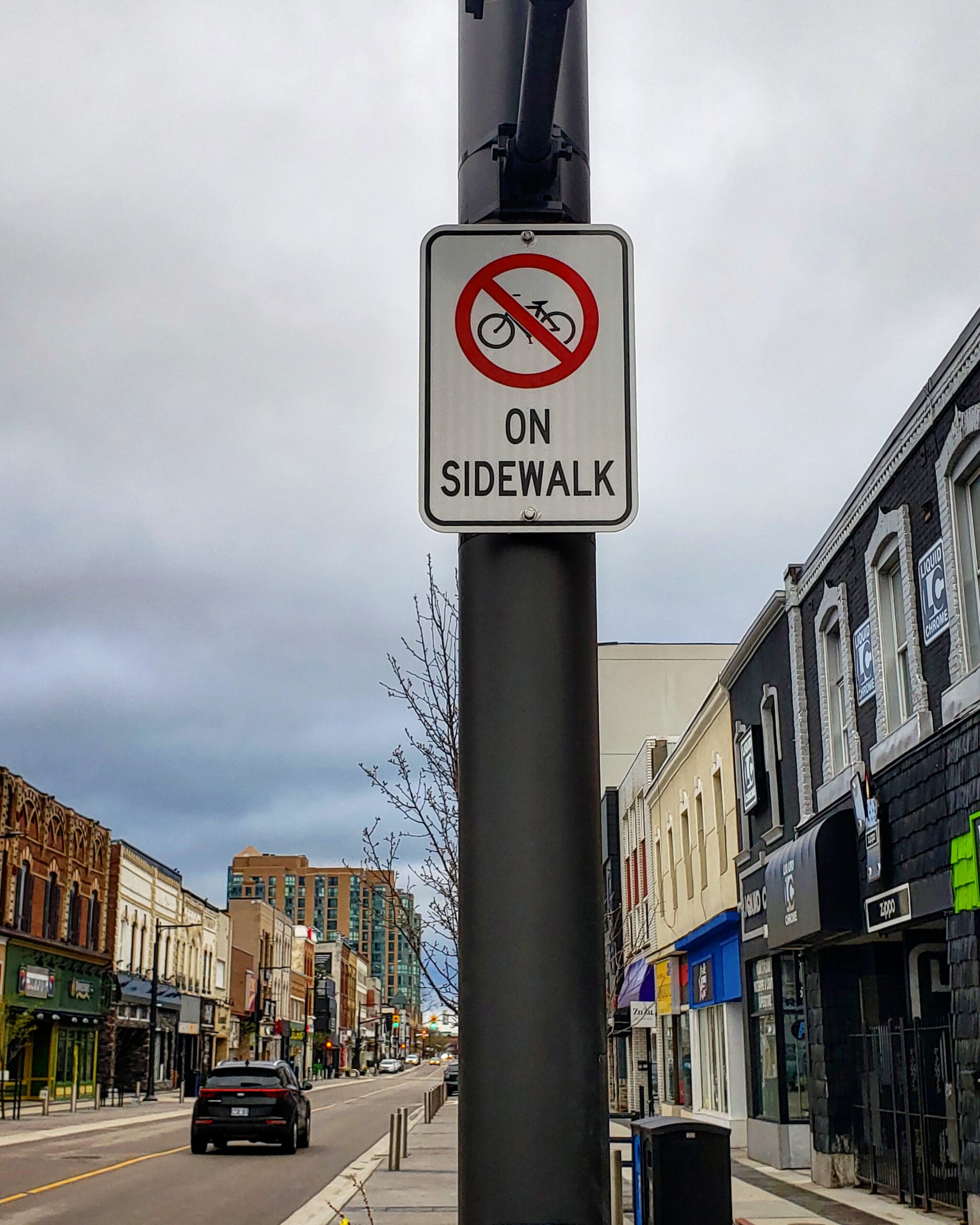
What was it like in Barrie during this recent pandemic and how is it now?
When Canada was hit by a SARS outbreak in 2002/2003, we had a total of 251 cases, and we threw a giant concert the very second it was over, with 500,000 people in attendance. I think when covid began we all thought it would be the same thing—not a huge deal here. And then we watched the wave spread over Europe and towards us.
By mid-April everything came to a standstill. The number of customers visiting the cafe suddenly dwindled, and we abruptly switched to doing takeout only. Sure enough on Tuesday April 17th a state of emergency was declared, and we were issued a stay-at-home order.
The cafe stayed closed for a couple of months, and like many Canadians in the same situation, I was fortunate to have my income supplemented by government support during that time. It was a taste of Universal Basic Income.
I’ve since returned to work. Restaurants in Canada and Ontario especially have been hit hard by the long-drawn-out lockdowns. The premiere of our province has mishandled things terribly. However, I’m fortunate to have a boss who puts our safety at the forefront. Despite being allowed at times, the cafe hasn’t opened yet for dine-in since the pandemic began. We’re working towards it, now that everyone on staff is double-vaxxed.
Because our downtown is the gathering place for our community, it’s also become the gathering place of anti-mask and anti-vaccine protestors, many claiming that the pandemic is a hoax. Frustrated with the long lockdowns, they began assembling in numbers this spring, taking over our downtown on Saturdays, typically the busiest business day. Their misdirected anger scared off a lot of shoppers and became a magnet for far-right extremists who were all too glad to have a captive audience. We were horrified to watch Donald Trumpian ideals spouted on the stage of our town square. Especially as a variant of the virus had just ravaged a nursing home in Barrie, where all but one of the 127 residents became infected and 77 died, along with a caregiver who worked there.
After about seven Saturdays of rallies, during a stay-at-home order, many of us were tired of standing back and watching. The police in town continued to “monitor the situation” but little was done to discourage the gatherings. The guest speakers sweeping in were becoming more problematic, and white nationalist groups were spotted in attendance.
Not wanting to violate the stay-at-home ourselves, we had to get creative with our counter-protest. On the seventh Saturday, I met early that morning with a group of friends at the space where the protestors planned to gather; we chalked the names of 100 people who had died of covid in Ontario, to honour those who had been lost. We also wrote messages such as hate has no home here, masks save lives, and we love gay people, to counteract the views of the day’s guest speaker.
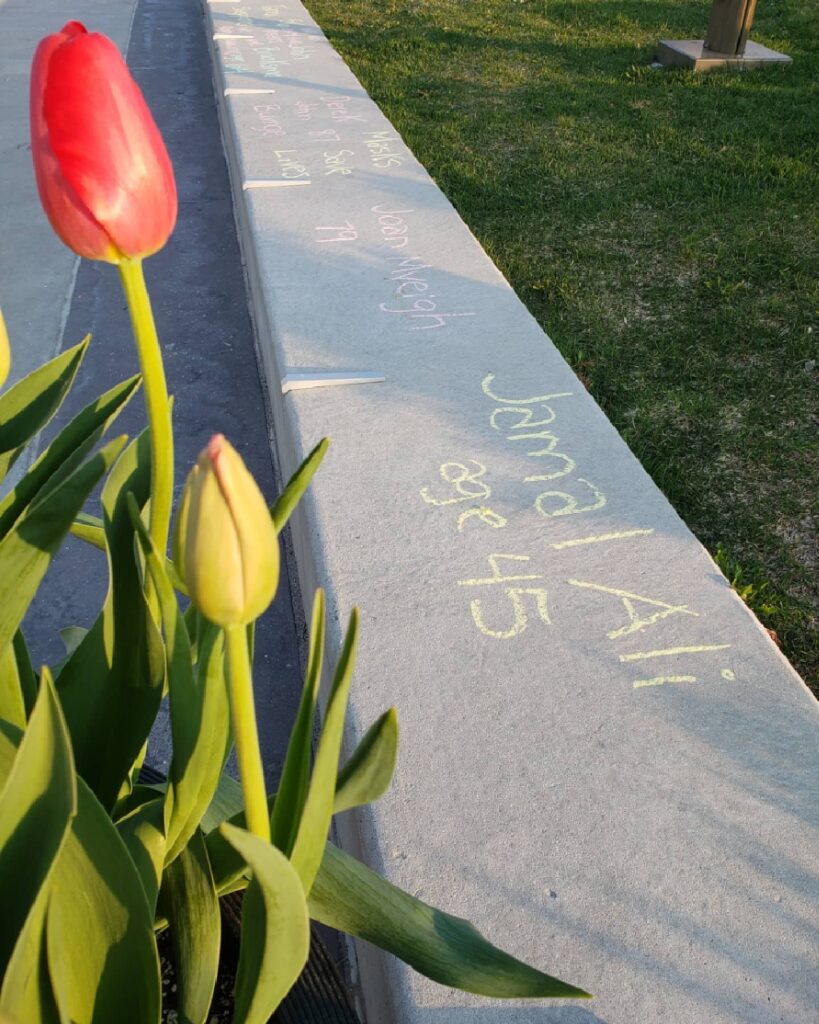
Other friends hung banners painted on sheets from nearby buildings with similar messages. And a couple others parked their cars close-by and blared their horns when the speaker appeared on stage and spoke.
Media later caught the protestors trying to wash the names and messages away. Though they’d been losing support on their own, I think public opinion really swayed against them that day.
Shortly after, the public square was fenced off by the city. The protestors gathered in smaller numbers a couple more times in other spaces. Legal action was finally taken against the rally’s organizer. For a while everything calmed down, and it looked like the pandemic might be winding down. Despite a delayed start, Canada quickly vaccinated a large number of citizens, and we’re fortunate to currently be in a fairly good place, all things considered.
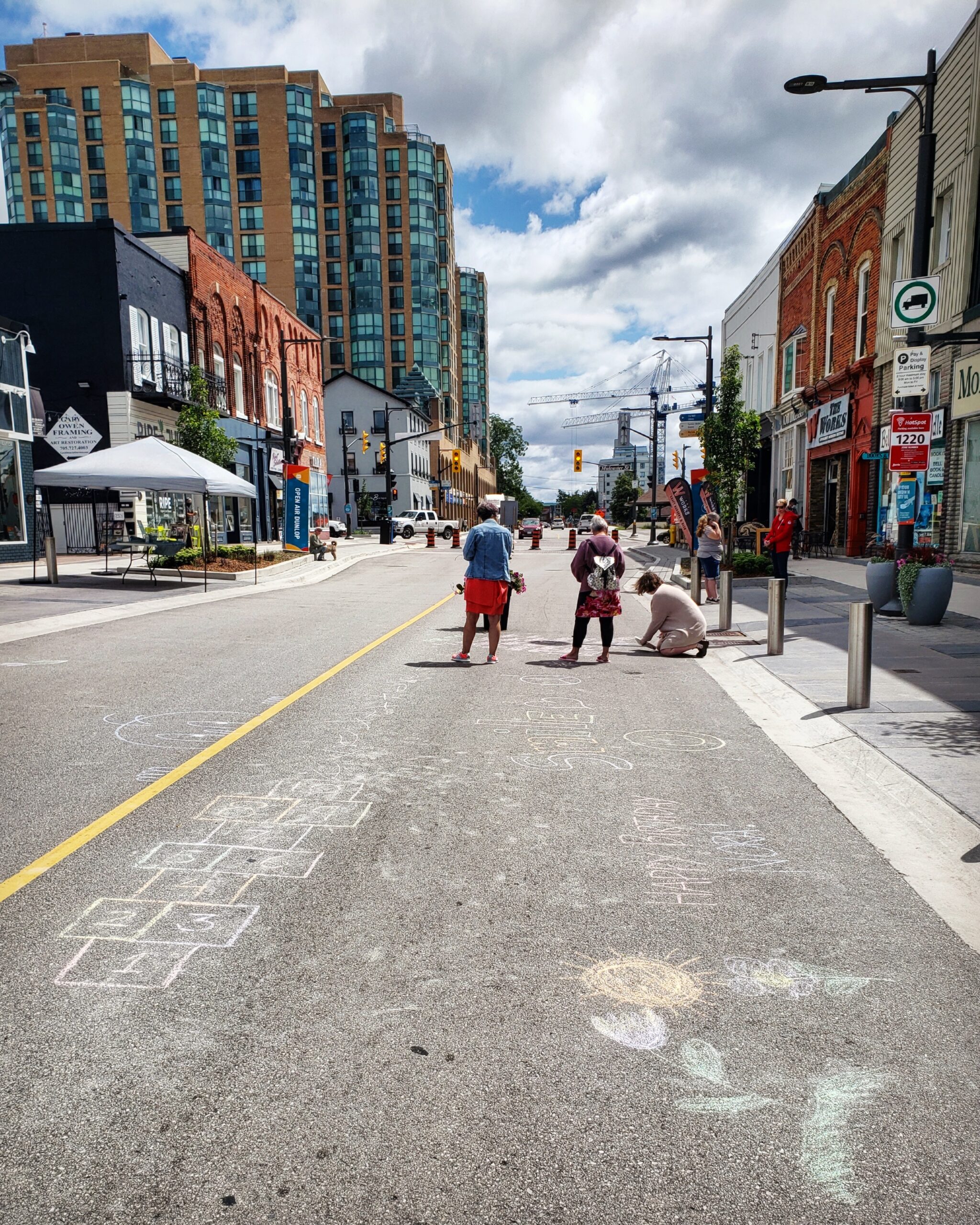
Case numbers seem to be creeping back up, however, and with kids going back to school soon, it looks like a fourth wave is approaching. Last weekend, another rally was planned by an out-of-town extremist. In a quick-thinking act, a local wrestling school scheduled use of the town square’s stage for live demonstrations, being sure to set up early and ensure the space couldn’t be claimed for nefarious purposes. Time will tell how the story continues to unfold.
Plans for the future at Heart of Barrie?
The Heart of Barrie has evolved since its inception and will continue to. For the time being it’s an Instagram Page, but perhaps someday it’ll make the leap to TikTok or back to a printed publication once more. Or maybe I’ll direct the energy in other ways. This week in particular the Heart of Barrie is planning a plant and seed swap downtown. Maybe it’ll involve a run for city council in the future. Regardless, the Heart of Barrie needs to be something bigger than myself. My hope is that in one way or another it’ll be something that inspires people to get involved in their community.
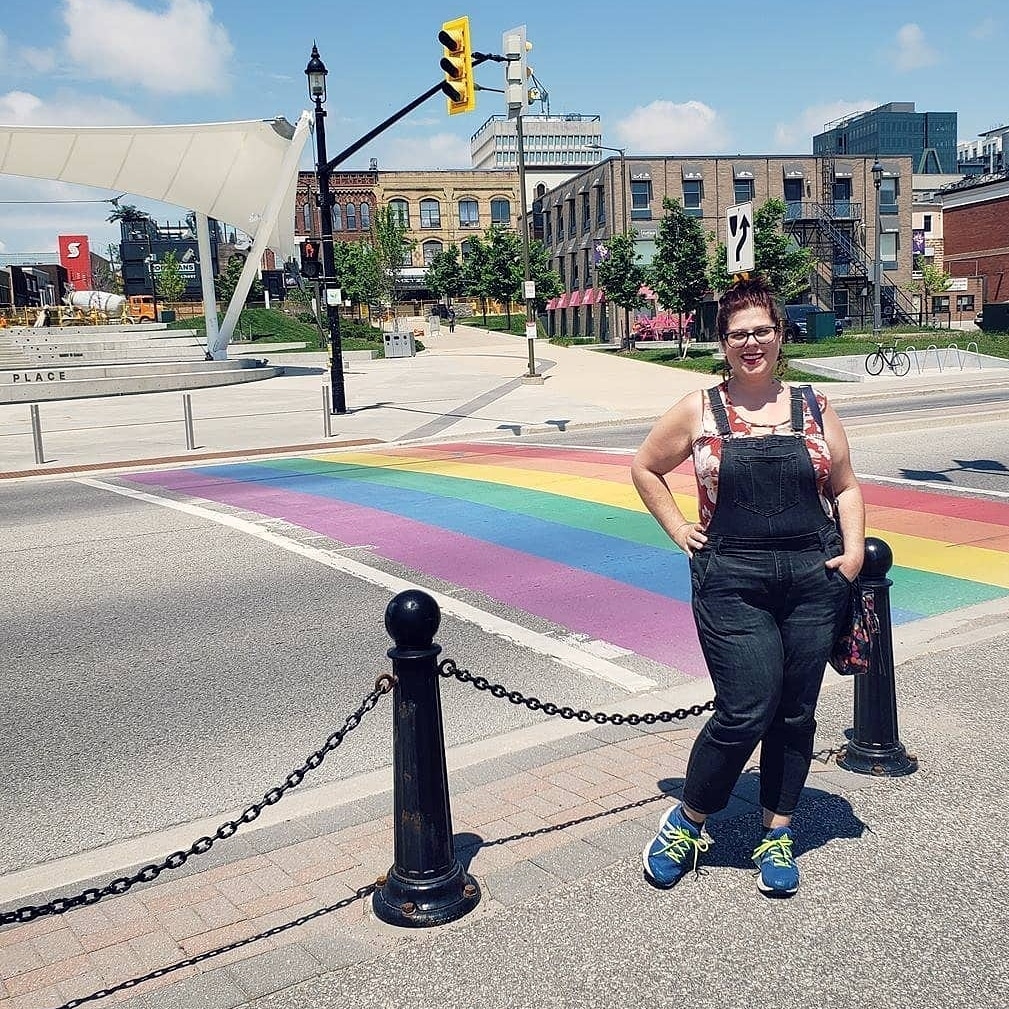
Sarah, thank you for your time with this interview and for providing the world with such an engaging view of Barrie and a continuous demonstration of lively community engagement.
Visit Sarah and Barrie online @the.heartofbarrie.

